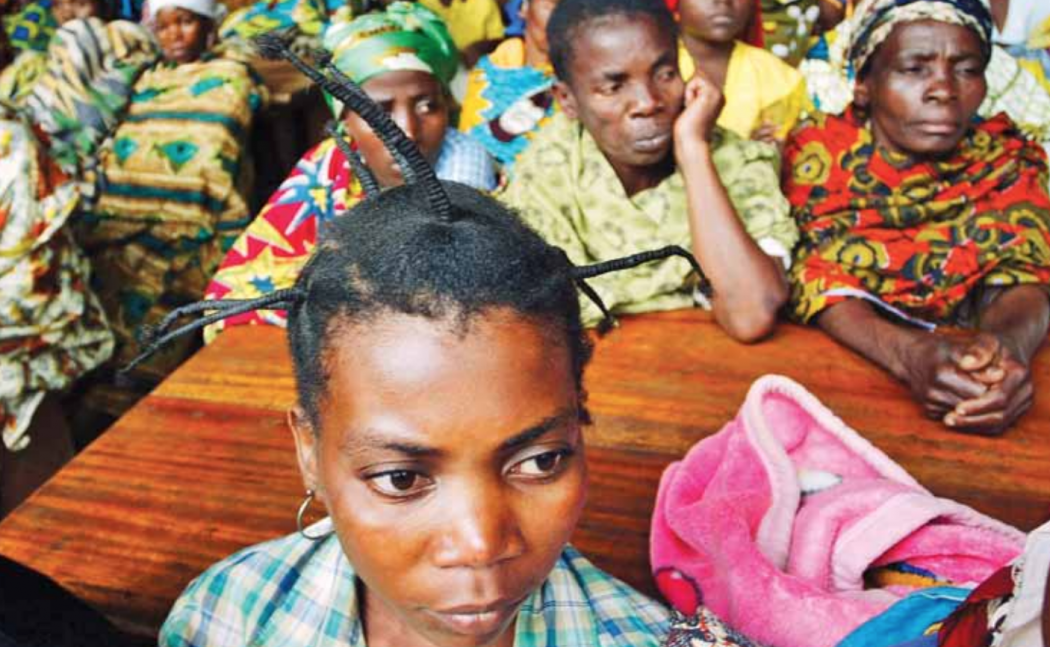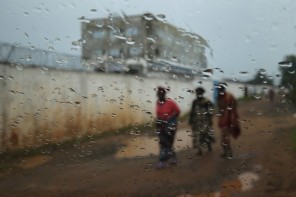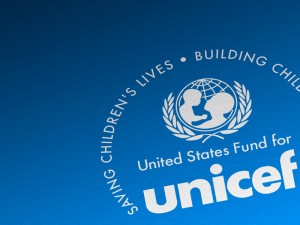But first, a quick news update: A Congolese colonel is going to jail for his sex crimes. It’s the first such conviction — and about damn time. Two thousand people attended the verdict and sentencing, and 49 women had braved testifying against him in court, according to the BBC. I applaud you all.
If you’re a regular reader, you’ve probably noticed by now that I write a lot about rape, in particular how journalists cover it. This surprises the me-of-five-years-ago. Then, I was in grad school with brilliant, fiery feminists who would have had a lot to say about this question if we’d ever had a class on it. I had virtually nothing to say about “that woman’s issue,” then…and sometimes felt like less of a woman (and certainly less of a feminist, if I even felt like that confusing f-word at all) because of my empty brain.
But in the intervening years, I’ve covered countries where you can’t get away from rape — or at least from its legacy. I spend a lot of time in post-conflict Africa, and in very nearly every country I’ve reported in, there’s a local variation on the “rape as a weapon of war” story. I’ve found myself puzzling through awkward systems of journalism logic. In Sierra Leone, for a story about a new precedent in international humanitarian law, I talked for hours with women who were gang-raped, or once-raped, or raped by the same man with different objects, and any other variation you can imagine. I’d been told this topic was sensitive, even urged by well-meaning NGO folks not to ask about it. But as soon as I had the introduction out of my mouth — “I’m a journalist writing about forced marriage during the war” — they interrupted me to start telling their stories. I was young, confused, overwhelmed, but slowly, I realized these were women who hadn’t been heard before.
Meanwhile, my story was narrow. At some point in each interview — sometimes five minutes in, sometimes twenty, depending on the person and all kinds of verbals and non-verbals — I had to ask questions that subtly tried to uncover whether their stories were the ones I needed for my story. Were these women who fit the Special Court’s new legalism “forced wives?” The precedent-setting case was all about how a forced marriage is a distinct crime, different from rape or sexual slavery, already defined (and sadly oft-used) in international law. I found myself thinking like a math teacher: All forced wives are raped, but not all rape victims are forced wives. It was an odd kind of consistency to have to maintain between the memories women wanted to share with me and the lens of the story. How do you tell a woman, “What you went through was horrible…but a different kind of horrible than I’m writing about?” (For the record, you don’t. I think you just listen, as long as you can, and thank them.)
Later, in Rwanda, I interviewed a genocide survivor who told me about the weeks she spent hiding from the interahamwe, gangs of young genocidaires who did the brunt of the killing. She told me about how men beat her and those around her, killed her family, tore her clothes off and then cracked her own skull with a weapon, leaving her to die.
She didn’t say what happened in between when they took her clothes and when they struck her. I had to decide whether to ask. I had a hunch — mass rape was a tactic of genocide — and a hunch is what leads a journalist to ask questions. Also, journalists have to be loyal to the story they are telling, and to tell all of it, even the uncomfortable parts. When we sit down to interview trauma survivors, we know this is going to make them uncomfortable. That’s why we do our best to explain why we’re asking and give them the freedom to choose to say no. We have to trust that we explain our mission and its risks — and at some point, we also have to trust their consent.
But there are times when we also have to recognize that these stories belong first to someone else. I decided not to press. I was telling a story, yes, but it was her story, and this was one part of that story I felt I had no business asking for if she didn’t want to give it to me. (There’s a corollary to holding back, of course, which is that maybe someone needs help with the thing you don’t ask… and so later I did ask her later, in a women-only room, if she has had access to the medical services and any medications she may need since the war. She said she had. The truth? I don’t know, but I let it be. It was the truth she wanted me to have.)
And after all this morally fraught reporting comes the writing. I’ve come to understand, from talking to some reporters and editors and from analyzing others’ work, that as a group, we journalists seem to think of writing as the easy part — or at least the part that’s not fraught. It’s easy to forget that how we put that story in the world — what quotes we use, what details we choose, what medium we use, what we focus on and what we ignore in the arc of our story — is just as important as how we report it.
In fact, I think it’s a big part of whether a piece of journalism can be considered ethical. And I think the fact that all kinds of readers from all kinds of backgrounds object when, say, the name of a nine-year-old Congolese is published in a national US newspaper suggests that readers also think how and what we write (or broadcast, or blog, or Tweet) is an important indicator of whether we are trustworthy, ethical journalists.
All of which is to say, here’s “The Pornography Trap, or, How Not to Write About Rape,” my piece from the January/February issue of the Columbia Journalism Review (pdf). (It’s still behind a paywall on their website, but I got permission to post the PDF.) It’s a consideration of the ways in which writing — whether on the page, or for television or radio, or even on Twitter — telegraphs to readers the thing they most need to know when they’re reading a trauma story: whether we reporters are trustworthy.
I’d love to hear what you think.




I read the story a few days ago in CJR which I pick up occasionally, as much for the falling on the floor laughing “the lower case” headlines as anything else. Always a lot of good stuff in any issue but here was a story by Jina Moore who should be published more widely–“The Pornography Trap” is moving, insightful and should be read by anyone reporting on rape trauma.
From the intro above: “Also, journalists have to be loyal to the story they are telling, and to tell all of it, even the uncomfortable parts. When we sit down to interview trauma survivors, we know this is going to make them uncomfortable. That’s why we do our best to explain why we’re asking and give them the freedom to choose to say no.”
This sums things perfectly, particularly necessary to be loyal to the story and to tell all of it.
Thanks so much.
This is really excellent. I work with women who have had abortions and there is a lot of pressure for them to hand over their stories to advocates of both sides. We are working on creating forums where women can speak for themselves and be heard with dignity and respect – across the range of personal experience and political beliefs. Ethical storysharing is always important but even more so now, as the internet makes it is easier to lose control of ones own narrative. Thanks for this insightful piece.
Thanks for leaving a comment, Aspen. I’m intrigued by your insight about the Internet — that it’s easier to lose control over one’s story. It’s the opposite of the prevailing wisdom. I have a taste for the counter-intuitive, but your comment also seems spot on — especially in terms of losing the context of our stories, what with all the cutting, pasting tweeting…
Yes, that’s very true. Our organization has been investigating how women make choices about whether or not to tell their abortion stories in public and have found that there is a spectrum from private to what I call “super public” (i.e, places like YouTube). And that there are considerations along this spectrum which determine where they choose to share, and what they need to feel supported in sharing. The frustrating part is the conventional wisdom is saying that *only* stories that are shared in “super public” formats, like YouTube, are valid. Private spaces, or semi-private spaces, are not considered worthwhile. It speaks to the difference of whether or not a forum is created for a woman to be heard, or for a story to be shared. Not the same thing. My interview with Amy Hill of the Silence Speaks project of the Center for Digital Storytelling, about this issue, here: http://exhaleisprovoice.wordpress.com/2010/04/27/the-expert-teacher-when-stigma-is-part-of-the-story-aspen-baker-interviews-amy-hill/
Thanks for that link, Aspen. I’m whirling around at the moment but hope I get a chance to give that some good attention this weekend. I’m really interested in what you’re saying.
Jina, I just want to say a big thank you for writing the sentences you have, for articulating what so many of us feel and think so clearly. I couldn’t agree more with you about how so many journalists tend to forget about the reader, leave alone imagining them as partners in a story. I work with an organisation in Chennai, India on a gender-based violence programme and one of the things we did last year was bring together a group of senior journalists to develop a set of simple guidelines for reporting on GBV. It was a difficult exercise in many ways for so many reasons – ones I’m sure you’re familiar with!
I’d love to get some feedback from you on these guidelines, they are very broad guidelines and obviously remain a work in progress. They are available here: http://www.prajnya.in/5rulesmedia.pdf
Thanks for this, Anupama. I’m jazzed to learn about your program, and I’ll give that link a look this weekend!
Anyone who has ever said in a group of friends, at a fundraiser, at a PTA mtg, at your kids hockey games, at a college reunion, etc…in response to “What do you do?” “Oh, I work at a rape crisis center…domestic violence shelter…abortion provider… I’m a SANE nurse.” Will resonate with your experiences.
There will be the initial yet silent “ugh” as people wiggle and move away or try to quickly change the subject after the awkward silences are filled. But then… the self selected return, slowly, pull you aside… the women, our sisters, our friends, that girl in high school who tormented you, the mother of your son’s best friend, the clerk at your grocery store, the coach, your cousin… Full of stories they need to share to someone they have just discovered might be safe to share to.
Some of us are here to listen quietly. We hold hands, keep secrets, and slowly stop going to public functions or admitting what that job is now because it is just too much to know that many secrets about one small community.
Some of you have the vision to open the door and invite the stories in. To find safe venues for public sharing. You make our lives easier. Thank you both for your courageous work, the strength to start the public dialogue, and the wisdom to know that it is time!
Thanks for these thoughts, Kim. I love the way you describe the secret life of community secrets — and hint at the difficulty of being the person to hold them. Such a valuable perspective.
I really appreciated this reflexive piece – I saw it on the CS Monitor web page. Your comments touch me in two areas. First, I’ve lived and worked in west and central Africa most of the last 17 years. The amount of violence, discrimination and other injustices I’ve seen against women overwhelms me, makes me angry, ties me up in emotional knots. Like you, I wouldn’t have imagined myself involved in women’s studies of any kind, but I find myself more and more drawn to issues and phenomena that touch women – not necessarily to the exclusion of men, but that affect women in unique ways. Second, as a sociolinguistic researcher, I also wrestle with the ethics of research and writing. It is very true that the area of consent we tend to focus on is getting the information, and not always the very important part of how we represent people and situations. Thanks for your reflections on fieldwork.
Annette, somehow I missed your comment. I’m so sorry for that as I’d like, first, to thank you, and second to ask you about your work. I’d be intrigued to hear how these questions come up for you in the course of your research. Hope to continue the conversation.
1. When you write, “the name of a nine-year-old Congolese is published in a national US newspaper” you decided against publishing the name of the US journalist Nicholas Kristof who published the name of the nine-year old rape survivor against the rules of the New York Times. Could you explain your reasoning behind leaving his name out of your blog post? I know you’ve included it in your CJR piece, but that’s less google-able.
2. You write about individual journalists’ treatment of the subject of rape, but how about organizations use of rape to further their mission? What do you think about Foundation Rwanda’s “Intended Consequences” piece and how the subject matter and individuals have been used?
Thanks, Jina.
Hi Joseph, thanks for reading. To answer your questions:
1. I’ve written about that, using his name, extensively. If you deploy those google powers, you’ll find those blog posts quickly. Regular readers know those posts, and I didn’t feel other readers needed his name in the course of my introductory post. I disagree with his reportorial and writing choices quite often (you’ll find other posts about this, too), but reasonable people disagree quite often in the world. I don’t want to have the Nick Kristoff fight again (but there are plenty of people all over the Internet who really like to have that fight, so I don’t think I’m doing anyone with objections to raise a disservice); I wanted to raise examples of difficulties from my own work — situations in which reasonable people could disagree about whether I made the “right” choices. You’ll also note in my article an argument that journalists find ways to share more with readers about the origins and process of their work; this was my attempt to share more with interested readers about the origins of that story.
Alas, I too wish the article wasn’t stuck behind a pay wall. I think it might be of good use to some journalists, and it drives me nuts that they can’t access it. Which is one reason I’ve loaded it here.
2. I’ve written, in other places, quite a bit about how organizations use rape. (I have a pretty good 12,000-word piece on the strategic use of rape I’d be happy to send you if you provide me with your email address instead of my own.) I think understanding that better is important. But that wasn’t the goal of the piece in CJR, whose readers are (mostly) journalists.
As for “Intended Consequences,” I think attempts to document these voices are often compelling and, in Rwanda, sometimes quite urgent. I don’t want to get into a role where I’m offering an opinion on every bit of rape representation ever put into the world, but if you have specific thoughts you’d like to discuss, I’d be happy if you dropped me a line.
Thank you for this wonderful and honest essay, Jina, and the conversation it is sparking.
I also think I hear you saying that you must be acutely aware of your own goals when entering into an interview, and how those goals determine what you do or do not choose to hear, let alone report on. Questions can mask intent just as much as they reveal intent.
That’s really well put, Thaler. Thanks.